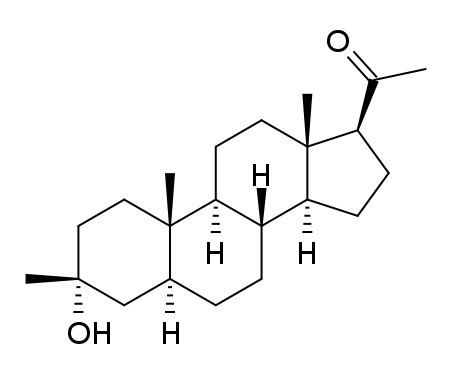ATC code none CAS Number 38398-32-2 ChemSpider 5293511 | Legal status investigational PubChem CID 6918305 Molar mass 332.52 g/mol | |
 | ||
Synonyms CCD-10423β-Methyl-3α-ol-5α-pregnan-20-one; 3α-Hydroxy-3β-methyl-5α-pregnan-20-one | ||
Introduction of ganaxolone as a treatment for pcdh19 female pediatric epilepsy
Ganaxolone is a CNS-selective GABAA modulator that acts on well-characterized targets in the brain known to have anxiolytic and anticonvulsant effects. Ganaxolone protects against seizures in diverse animal models, including the pentylenetetrazol, 6 Hz, and amygdala kindling models. Ganaxolone is a positive allosteric modulator of the action of the GABAA receptor and, unlike benzodiazepines, there does not appear to be tolerance to the anticonvulsant effects of ganaxolone.
Contents
- Introduction of ganaxolone as a treatment for pcdh19 female pediatric epilepsy
- Mechanism of Action
- Clinical trials
- Focal onset seizures
- Fragile X syndrome
- References
Ganaxolone is being investigated for potential medical use in the treatment of epilepsy. It is well tolerated in human trials (with exposure of >1,300 patients), with the commonly reported side effects being somnolence (sleepiness), dizziness, and fatigue.Trials in adults with focal onset seizures and in children with infantile spasms have recently been completed. There are ongoing studies in patients with focal onset seizures, PCDH19 pediatric epilepsy, and behaviors in Fragile X syndrome.
Mechanism of Action
The exact mechanism of action for ganaxolone is unknown; however, results from animal studies suggest that ganaxolone works by blocking seizure propagation and elevating seizure thresholds.
Ganaxolone is designed to modulate both synaptic and extrasynaptic GABAA receptors to calm over-excited neurons. Ganaxolone's activation of the extrasynaptic receptor is an additional mechanism that provides stabilizing effects that potentially differentiates it from other drugs that increase GABA signaling.
Ganaxolone binds to allosteric sites of the GABAA receptor to modulate and open the chloride ion channel, resulting in a hyperpolarization of the neuron. This causes an inhibitory effect on neurotransmission, reducing the chance of a successful action potential (depolarization) from occurring.
Ganaxolone's mechanism is similar to allopregnanolone; however, the addition of the 3β-methyl group to the chemical structure prevents ganaxolone from being metabolized like allopregnanolone into an active hormonal steroid. This makes ganaxolone devoid of undesirable hormonal side effects. In binding studies, ganaxolone showed no appreciable affinity for estrogen or progesterone receptors, confirming ganaxolone's lack of hormonal activity.
In animal pharmacokinetic and in vitro studies, ganaxolone is shown to be primarily metabolized by CYP3A.
Clinical trials
Ganaxolone is currently being investigated for potential medical use in the treatment of epilepsy and behavioral disorders.
In Phase I and II clinical trials, ganaxolone has been administered in approximately 1,300 subjects at therapeutically relevant dose levels and treatment regimens for up to two years. [10] In these clinical trials, ganaxolone was generally well tolerated, with no adverse effects on cardiovascular, liver, blood or other systems.
The most common adverse events reported across clinical trials are somnolence (sleepiness), dizziness, and fatigue. Most of the adverse events reported in the clinical development program were mild or moderate in severity, dose-related, resolved upon treatment discontinuation, and expected based on ganaxolone pharmacology.
In preclinical and clinical findings, ganaxolone exhibits a relatively safe reproductive toxicity profile, especially in comparison to currently available anti-epileptic drugs.
Focal onset seizures
Ganaxolone has been tested in a randomized placebo-controlled Phase II clinical trial as add on therapy for adults with drug-resistant focal onset seizures. People were randomized to receive either ganaxolone or placebo in addition to their current anti-epileptic drugs. The primary endpoint of the study was the absolute reduction in seizure frequency, with secondary endpoints including the percent change of mean weekly seizure frequency from baseline and responder rate.
In the study, ganaxolone showed a reduction of mean weekly seizure frequency versus the placebo arm during the titration and maintenance period (p=0.042). The data also demonstrated a difference of 20% mean seizure reduction from baseline compared to placebo (p=0.0144). Responder rates were numerically larger in the ganaxolone arm, but did not reach statistical significance in the study (p=0.057). In a post hoc analysis, significantly more ganaxolone treated patients achieved ≥30% improvement in weekly seizure frequency (p=0.027).
Fragile X syndrome
The MIND Institute at the University of California, Davis, in collaboration with Marinus Pharmaceuticals, is conducting an exploratory, randomized, placebo-controlled, Phase II proof-of-concept clinical trial evaluating the effect of ganaxolone on behaviors associated with Fragile X syndrome in approximately 60 children and adolescents.
